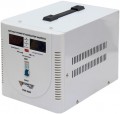The type of voltmeter provided in the design of the stabilizer, or rather — the type of scale used by this device. This
voltmeter itself allows monitoring of voltage — usually both at the input and output — which facilitates control over the stabilizer's operation. For this purpose, two separate scales are most often provided, but there are also "single" voltmeters with a switch to choose between input and output voltage. As for the type of scales, the following options are available:
— Analog. Analog voltmeters are equipped with a traditional type of scale — with divisions marked on it and a needle. They are simpler and cheaper than digital ones, but less accurate — even in the most precise devices, the error in readings can be 5-10 V just due to the peculiarities of reading information from such a scale. In some inexpensive models, analog voltmeters serve more as general indicators rather than precise instruments. At the same time, for most everyday tasks, such accuracy is quite sufficient.
— Digital. In such voltmeters, the role of the scale is played by a digital
display, where voltage values can be displayed with an accuracy of up to a volt — this is the main advantage of this option over analog. The drawbacks include the complexity and relatively high cost of digital indicators. Moreover, such high accuracy may be critical in the professional field, but in everyday life, it is not
...always necessary. Accordingly, in inexpensive low-power stabilizers, a digital voltmeter is often more of a marketing ploy than a real necessity.
